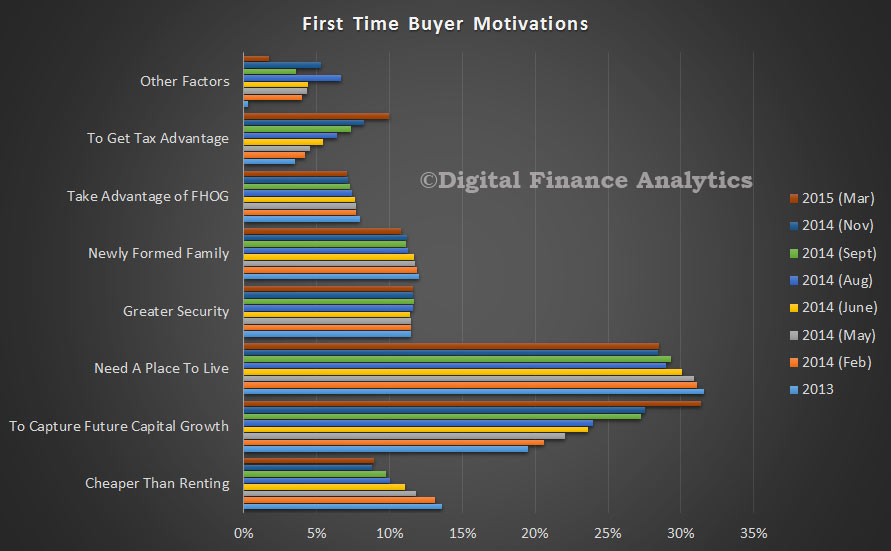As explained in the segment by Martin North from Digital Finance Analytics, nearly one half of all FHBs who are active in the market went into the investment sector, and their numbers have risen from very low levels during the GFC to about 4,000 people each month:
There’s no doubt in my mind that there is a very strong motivation to get into property. It’s something which I think Australians have always had, but they can’t necessarily go through the front door, but they still want to get into the market and this investment route gives an alternative, if you like, a backdoor entry into the marketplace. They continue to live at home or with friends or family paying rent. So rather than actually being an owner-occupier first and then moving into an investment property later, they’re going directly into the investment sector. We are effectively becoming a nation of landlords…
North, of course, has been tracking FHB’s for quite some time now, and notes that their primary motivations for entering the market are capital gains (32%) and the desire for somewhere to live (28%), with the former growing in importance and the latter shrinking. The prospect of gaining a tax advantage is also growing, now up to 10%, suggesting a strong speculative element creeping into the market (see next chart).
The ABC 7.30 Report segment profiles two FHB investors, who hope to either utilise first home buyer grants and/or negative gearing to break into the market.
The first, Tom Milton, has gone deep into debt ($710,000) and purchased a house in Melbourne’s inner north and plans to redevelop it into three units. Whereas the second, Sam Edwards, has just put a deposit on a $400,000 off-the-plan apartment in Canberra, which he hopes to live in for 12 months (to qualify for the FHB grant) before renting-out and utilising negative gearing.
Both FHBs are hoping talks of a housing bubble are misplaced:
SAM EDWARDS: I mean, I am slightly worried, but, I mean, the housing market does fluctuate every now and again and, I mean, here’s always positives possibly in the future to come and that’s what I’m hoping for. And I guess that, in order to invest in my future and in my family one day, that I’d like to have something like this…
TOM MILTON: I mean, I guess it is risky. There’s no guarantees with this sort of thing. I don’t know what’s going to happen with interest rates, I don’t know what’s going to happen with the house values in this area and more generally in Australia. I mean, I certainly hope that the talk of a bubble is not a bubble that bursts, but maybe a swelling that goes down.
Clearly, based on Martin North’s data, Australia’s FHBs are increasingly viewing housing as a wealth building tool rather than somewhere merely to live. Purchasing decisions are also being based on fears of missing out, and the view that delaying potential entry into the market will make it less affordable later.
While everything worked out well for their parents, who built substantial wealth as Australia’s house values exploded, values are now at all-time highs. When added to the massive structural adjustment facing the Australian economy – notably the ongoing fall in commodity prices and mining investment, along with the closure of the car industry – as well as the lack of significant downside for mortgage rates and the sluggish growth in both incomes and rents, now is an incredibly risky time for FHBs to be leveraging-up into the housing market.


